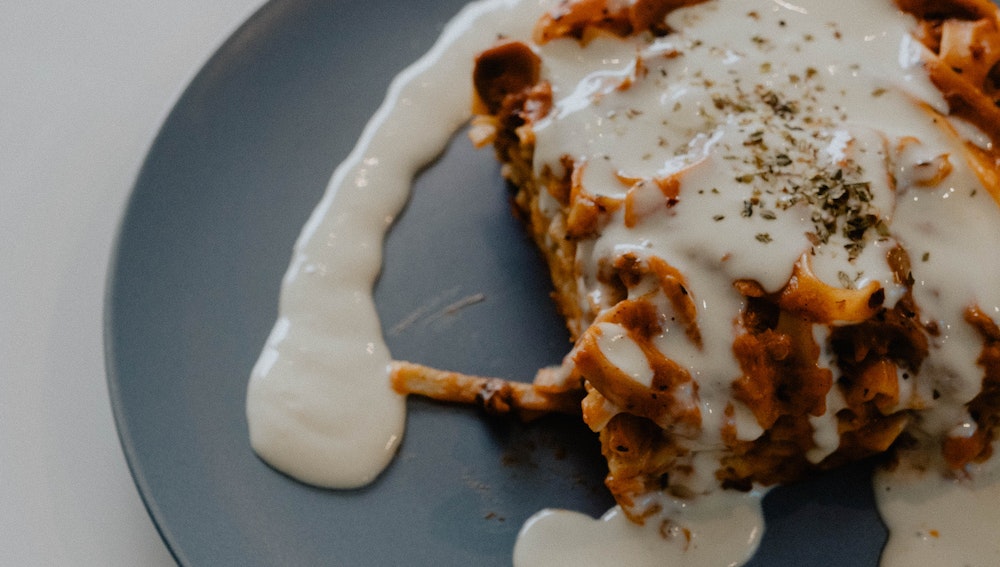Cream sauce, known for its rich and silky texture, has been a beloved staple in various cuisines for centuries. However, there are instances where one might need a suitable substitute due to dietary restrictions, personal preferences, or simply running out of ingredients.
This article offers several cream sauce base alternatives that cater to a variety of needs and preferences while maintaining the luxurious mouthfeel of the original version.
Finding the perfect substitute for a cream sauce base might seem challenging at first, but with the right knowledge and techniques, you can create delicious sauces that satisfy your cravings without compromising flavor or texture.
From dairy-free options to healthier alternatives, this article discusses different methods and ingredients that can be used as an effective cream sauce base substitute.
Key Takeaways
- Discover dairy-free and lower-fat cream sauce alternatives for various dietary needs.
- Learn about the art of roux and its role in creating cream sauce base substitutes.
- Enhance your sauces with additional ingredients and explore diverse pairing suggestions.
The Quest for the Perfect Cream Sauce Base Substitute

Finding the perfect cream sauce base substitute for your recipes can be a challenge, especially when you want to create that rich and creamy texture without relying on traditional ingredients.
However, with a little creativity and experimentation, it is possible to create a satisfying alternative that still delivers the desired flavor and consistency.
One of the most popular ways to substitute for a traditional cream sauce base is by using a combination of dairy-free alternatives.
For example, almond milk or cashew milk can be used in place of heavy cream in a recipe, while a blend of nutritional yeast, tofu, or vegan cream cheese can add richness and creaminess to the sauce. These ingredients can help maintain the desired texture and consistency of a cream sauce, particularly in pasta dishes.
Another option for a cream sauce base substitute is utilizing vegetables for a healthier and more nutritious alternative. Cauliflower and white beans are excellent options as they can both be pureed into a creamy consistency and have a neutral flavor.
For instance, by boiling and blending cauliflower with a plant-based milk, nutritional yeast, and some spices, a creamy and delicious sauce can be created that pairs well with pasta or roasted vegetables.
If you’re looking for a specific recipe that offers a cream sauce base substitute, a great example would be Hello Fresh’s cream sauce base recipe. This recipe uses a combination of milk, vegetable broth, and cornstarch to create a thick and creamy sauce without relying on heavy cream.
By using these readily available ingredients, home chefs can recreate that classic cream sauce texture without the excessive fat content found in traditional recipes.
Overall, there are several alternatives for creating a delectable cream sauce base without relying on heavy cream or other high-fat ingredients. With a bit of imagination and by utilizing plant-based milks, vegetables, or a combination of other ingredients, anyone can create a lighter, healthier, and equally satisfying cream sauce for their favorite recipes.
Dairy-Free Cream Sauce Alternatives

Using Coconut Milk
Coconut milk is a widely used dairy substitute in cream sauces. It offers a rich and creamy texture, making it an excellent option for those who are lactose intolerant or avoiding dairy products for other reasons. One can use coconut milk as a 1:1 substitute for heavy cream in many recipes.
It works particularly well in savory dishes like pasta sauces and curry dishes, as well as desserts such as custards and mousses. Since the flavor of coconut can sometimes be noticeable, it is essential to choose a brand with a subtle taste or dilute it with another liquid.
Plant-Based Milk Options
In addition to coconut milk, there are various plant-based milk alternatives that can serve as a base for dairy-free cream sauces:
- Almond milk: With a mild and slightly nutty flavor, almond milk is a versatile plant-based milk alternative. It works well in both savory and sweet dishes. However, the consistency is thinner than that of heavy cream, so it may require a thickening agent such as flour or cornstarch.
- Cashew milk: Cashew milk has a rich and creamy texture. It is excellent for making dairy-free cream sauces, as it closely resembles the consistency of heavy cream. Blend soaked cashews with water to create a silky smooth milk that can be used as a base for various recipes.
- Soy milk: Another popular dairy substitute, soy milk has a neutral flavor and a thicker texture than almond milk, which can work well in cream sauces. It may also require a thickening agent if a thicker sauce is desired.
- Oat milk: This relatively new dairy-free milk alternative has gained popularity for its neutral taste and thick consistency. Oat milk works well in savory sauces and is commonly used in vegan dishes, such as alfredo sauce.
In conclusion, there are numerous dairy-free cream sauce alternatives that can accommodate various dietary preferences. With this variety of options, those avoiding dairy don’t have to sacrifice taste or texture when it comes to enjoying a delicious cream sauce.
A Lower-Fat Option: Using Yogurt

Yogurt is a versatile dairy product that can serve as an excellent substitute for cream sauces in many recipes. It offers a lower-fat option while still providing a rich and creamy consistency that contributes to the overall appeal of the dish.
Choosing the right type of yogurt is essential for achieving the desired outcome. Opt for plain, unflavored yogurt, preferably one with a thicker texture like Greek or drained yogurt. These types have a higher protein content and tend to hold their shape when heated, making them ideal for sauce bases.
To incorporate yogurt into your sauce effectively, there are a few techniques to consider. Firstly, you may want to whisk the yogurt to smooth it out and remove any lumps before adding it to your other ingredients. This ensures an even consistency throughout the sauce.
Additionally, it is beneficial to temper the yogurt by slowly adding a small amount of the hot liquid from your sauce into the yogurt while continuously whisking. This gradual temperature increase prevents the yogurt from curdling when added to the sauce.
One notable aspect of using yogurt as a cream sauce substitute is its signature tangy flavor. In specific recipes, the tang can complement the dish beautifully, particularly in Mediterranean or Middle Eastern cuisine. However, if a milder taste is desired, you can balance out the tang by adding a small amount of sweetener, such as honey or maple syrup.
In summary, yogurt is a fantastic low-fat alternative for traditional cream sauce bases. When used thoughtfully, it offers a smooth, creamy texture and richness without the added calories and fat found in heavy cream.
With careful consideration of the type of yogurt, proper preparation, and attention to balancing flavors, you can confidently serve delightful and healthier dishes to your family and friends.
Mastering the Art of Roux
A roux is a fundamental element in many classic sauces and serves as an excellent cream sauce base substitute. Typically made from just two ingredients, a roux relies on equal parts of all-purpose flour and unsalted butter to create a thick and velvety texture.
To create a perfect roux, begin by melting unsalted butter over medium heat. Once the butter is melted and foamy, gradually add equal parts all-purpose flour, whisking continuously to prevent clumping.
The mixture should form a smooth and homogenous paste. Keep cooking the roux, stirring constantly, to achieve the desired level of color and flavor.
There are several stages of color in a roux, each suited to different dishes:
- White roux: Cooked for just a few minutes until it loses its raw flour taste, a white roux is perfect for béchamel and other light, creamy sauces.
- Blonde roux: Cooked a bit longer until it turns slightly golden, a blonde roux adds more depth of flavor to dishes like velouté and cheese sauces.
- Brown roux: Cooked until it reaches a deep, rich hue, a brown roux is the ideal base for dark, hearty sauces like gravy or gumbo.
With a mastered roux technique, one can significantly improve the texture and flavor of their dishes while also avoiding many common sauce pitfalls. A properly made roux will not only act as a substitute for cream sauce bases but will also provide versatility and nuance to an array of culinary creations.
Cream Sauce Variations
There are numerous ways to create delicious cream sauce variations that can elevate any dish. By experimenting with different ingredients and flavors, it’s possible to find a cream sauce base substitute that’s both satisfying and unique. In this section, we’ll explore a few popular cream sauce variations.
Parmesan Cream Sauce: This is a classic variation of the traditional cream sauce, which combines heavy cream with grated parmesan cheese. When heated and mixed together, the cheese melts into the cream, creating a rich and velvety sauce.
This sauce is perfect for pasta dishes, vegetables, or as a topping for meats. To make parmesan cream sauce, heat equal parts cream and grated parmesan cheese in a saucepan until the cheese melts and the sauce thickens.
Herbed Cream Sauce: Adding fresh or dried herbs to a basic cream sauce brings a burst of flavor to the dish. Some popular herbs to consider include basil, chives, dill, parsley, or rosemary. For an herbed cream sauce, simply infuse the basic cream sauce with a variety of herbs, adjusting the taste according to preference. This sauce pairs well with fish, poultry, and vegetables.
Alfredo Sauce: Alfredo sauce is a popular Italian-inspired cream sauce made with butter, heavy cream, and grated parmesan cheese. This rich and indulgent sauce is a staple in Italian cuisine, particularly in pasta dishes like fettuccine Alfredo. To make Alfredo sauce, melt butter in a saucepan, add heavy cream, and cook until heated through. Stir in grated parmesan cheese until the sauce becomes smooth and thick.
In summary, there are numerous cream sauce variations that home cooks can experiment with to find the perfect balance of flavors and textures. By trying out parmesan cream sauce, herbed cream sauce, and Alfredo sauce, one can discover new and delicious ways to enjoy their favorite dishes.
Incorporating Dairy Substitutes in Common Dishes

Macaroni and Cheese
For a dairy-free macaroni and cheese, you can use a variety of dairy substitutes. Unsweetened and unflavored almond milk or cashew milk make the most desirable choice.
To create a rich and thick sauce, blend in soaked cashews or sunflower seeds. You can also add some nutritional yeast for a cheesy flavor. Alternatively, if you prefer, use a non-dairy cheese alternative, like vegan cheddar shreds or mozzarella-style shreds.
Casseroles
Casseroles are versatile dishes that can easily be adapted to accommodate dairy substitutes. In creamy vegetable-based casseroles, try using coconut milk or unsweetened almond milk to replace heavy cream. For a richer consistency, opt for a can of full-fat coconut milk.
When it comes to replacing cheese in casseroles, vegan cheese alternatives, such as soy-based cheese or cashew cheese, can be used.
Comfort Foods
Comfort foods like creamy risottos, soups, and stews often rely on dairy for their luscious and creamy texture. However, there are plenty of dairy-free alternatives that can be used in these dishes. Some options include:
- Almond milk: Use unsweetened plain almond milk as a 1:1 substitute for milk in your recipes
- Coconut milk: This dairy-free alternative works well in Asian-inspired soups and curry-based dishes
- Silken tofu: Blend silken tofu until smooth, and use it to thicken soups, creamy sauces, or stews
- Vegan sour cream or yogurt: Ideal for topping or stirring into dishes like chili, baked potatoes, and stroganoff to create a rich and creamy finish
Remember, when incorporating dairy substitutes into your common dishes, always ensure that they are unsweetened and unflavored to prevent unintended alterations to the taste and texture of your meal. With these alternatives, your favorite comfort foods can still be enjoyed while catering to dairy-free dietary needs.
Enhancing Your Sauce with Additional Ingredients
A good cream sauce base substitute can be elevated by incorporating various ingredients that impart rich and distinct flavors. In this section, we explore numerous components that can be mixed into your sauce to enhance its taste and texture.
Firstly, consider the type of cheese you want to add to the sauce. Many recipes call for Parmesan cheese due to its sharp and nutty flavor. However, you can also opt for different varieties, including Gruyère, cheddar, or gouda, depending on your preference.
Season your sauce with salt and a mix of peppers, such as black pepper and cayenne pepper. This combination of spices imparts a well-rounded heat and enhances the overall flavor profile of the dish. You may also consider adding a touch of dijon mustard or nutmeg for a unique twist.
An essential part of any sauce is ensuring the ideal consistency. To achieve this, some recipes might call for the use of flour as a thickening agent. If you’re working with a cream sauce base substitute, ensure that you properly incorporate the flour to avoid a grainy texture.
Finally, enhance the aroma and complexity of your sauce with dried herbs and powders like Italian seasoning, garlic powder, and onion powder. These additions provide a delightful depth of flavor that complements the richness of the cream sauce base substitute.
Remember to taste and adjust your sauce as needed while maintaining a balance between flavors. By experimenting with these ingredients and adjusting the proportions to your liking, you’ll be able to create a delicious, personalized cream sauce that elevates any dish.
A Closer Look at Bechamel Sauce
Bechamel sauce, also known as white sauce, is a classic French sauce made from a roux of butter and flour, combined with milk. It is considered one of the “mother sauces” in French cuisine, serving as a base for many other sauces and dishes. The sauce is known for its versatile nature and rich, creamy flavor.
The process of making bechamel sauce begins with creating a roux by melting butter and adding in flour, cooked together over low heat until it forms a smooth paste. This roux acts as a thickening agent for the sauce.
The milk is then gradually added to the roux, whisking constantly to prevent lumps and ensure a smooth consistency. The sauce is then cooked and seasoned with salt, white pepper, and sometimes a pinch of nutmeg for extra flavor. Bechamel sauce should be cooked until it reaches a desirable thickness.
One of the reasons bechamel sauce is so popular is its versatility. It can be used as a base for many different sauces and dishes, such as Mornay sauce (by adding gruyere cheese) or lasagna.
In addition to serving as a base sauce, bechamel can also be used for flavoring and binding ingredients in casseroles, gratins, and baked pasta dishes. The mild flavor of the sauce allows it to complement a wide range of ingredients without overpowering them.
There are several ways to customize bechamel sauce to suit different tastes and recipes. For a richer and more indulgent sauce, cream can be used in place of some or all of the milk. Cheese, herbs, and spices can also be added to create unique flavor profiles.
For example, adding Parmesan cheese, garlic, and Italian herbs transforms bechamel into a delicious Alfredo sauce.
In summary, bechamel sauce is a classic French sauce that serves as a versatile and flavorful base for a variety of dishes. Its rich, creamy texture and mild flavor make it a popular choice for both professional chefs and home cooks alike.
Experimenting with different ingredients and techniques allows for endless possibilities when it comes to creating delicious dishes using bechamel sauce.
Cream Sauce Preparation Techniques
Cream sauces are a versatile and rich component of many recipes. Preparing the perfect cream sauce base can seem daunting, but with a little practice and the right technique, anyone can master this essential culinary skill.
One of the primary aspects of creating a great cream sauce is choosing the correct base substitute. Traditional cream sauces are made with heavy cream or crème fraîche, but there are several suitable alternatives for those who desire a healthier option or have dietary restrictions. Some popular substitutes include:
- Greek yogurt: A thick, creamy alternative with a tangy flavor and fewer calories than heavy cream.
- Sour cream: A thick substitute, similar in consistency to crème fraîche, but with a slightly tangy taste.
- Milk or half-and-half: A lighter option, providing a similar consistency, but with less fat and a lighter flavor.
Selecting the appropriate roux is also essential in creating a luscious cream sauce base. A roux is a mixture of fat—usually butter—and flour, cooked together to form a paste. The three main types of roux are:
- White roux: Cooked for a short time, retaining a pale color and subtle flavor.
- Blond roux: Cooked slightly longer, resulting in a light brown color and a nuttier flavor.
- Brown roux: Cooked the longest, achieving a rich brown color and a robust, toasty flavor.
Choosing the right roux will depend on the desired outcome of the cream sauce. For a more delicate sauce, a white or blond roux is recommended, while a brown roux is suitable for heartier dishes.
When preparing cream sauce, the culinary technique known as tempering is essential. Tempering prevents the cream or base substitute from curdling when added to the sauce. To temper the cream:
- Gradually heat the cream or substitute separately, ensuring it is not boiling.
- Slowly whisk some of the hot sauce into the cream or substitute, a little at a time, until the temperature is similar.
- Finally, add the tempered cream back into the hot sauce, whisking continuously to ensure an even texture.
To further expand one’s cream sauce preparation techniques, consider attending cooking classes or investing in comprehensive cookbooks that cover essential techniques and recipes.
Developing proficiency in sauce-making is an important skill in the kitchen, and with practice and dedication, anyone can master the art of creating delicious, creamy sauces for a variety of dishes.
Pairing Suggestions

Chicken Pairings
For chicken dishes, a light and creamy substitute like Greek yogurt or a dairy-free option like coconut milk will complement the flavors well. You can use these substitutes in dishes like Chicken Alfredo, Chicken Piccata, or Chicken Marsala. The creamy texture and mild flavors will enhance the taste of the poultry without overpowering it.
Shrimp Recipes
Shrimp dishes often go well with less heavy sauce alternatives, as they have delicate flavors that require a balanced sauce. Consider using a cashew cream sauce, which can be made by blending soaked cashews with water until smooth. This rich, nutty base pairs perfectly with shrimp dishes like Shrimp Scampi or Shrimp Fettuccine.
Vegetable Enhancements
For vegetable dishes, a cauliflower-based sauce can be a great choice due to its versatility. By blending steamed cauliflower with various seasonings and spices, you can create a variety of sauces suitable for vegetables, such as a puree or a thick sauce. This option works well with dishes like vegetable lasagna, roasted vegetables, or stuffed bell peppers.
Steak Combinations
Steak dishes benefit from bold and rich flavors in their accompanying sauces. A great option for a cream sauce substitute in steak dishes is a red wine and shallot reduction. It adds depth to the flavor of the dish, while still providing a smooth and luxurious texture. This type of sauce works exceptionally well with grilled steaks, Beef Stroganoff, or Steak Diane.
Seafood
Seafood dishes benefit from lighter cream sauce alternatives that don’t overshadow the natural flavors. An excellent option is combining almond milk or oat milk with a thickening agent, like cornstarch, to create a velvety sauce.
This works well for dishes like seafood pasta, baked fish, or seafood risotto. The mild taste of the sauce blends effortlessly with the seafood, creating a harmonious dish.
Conclusion
In conclusion, finding the best cream sauce base substitute can be essential for those with dietary restrictions or simply looking to explore new flavors in their dishes. Several alternatives, such as milk and butter, coconut milk, soy or almond milk, and cashew cream, can easily be used to create delicious, creamy sauces without relying on traditional heavy cream.
Each option offers a unique taste and texture, allowing the cook to cater to specific dietary preferences and dish requirements. By experimenting with these substitutes, one can achieve a variety of dishes that are both delicious and accommodating to different tastes and eating styles.
It is important to consider ratios when making the substitutions, as well as adjusting other ingredients to achieve the desired consistency and flavor.
In short, a versatile range of cream sauce substitutes is available to suit many culinary needs, ensuring a satisfying experience for all. With some creativity and open-mindedness, the perfect alternative can be found, providing a delicious and rich creaminess to a variety of dishes without sacrificing on flavor or texture.
Related posts:
Frequently Asked Questions
What are common alternatives to heavy cream in sauces?
There are several alternatives to heavy cream that can be used in sauces to achieve a similar creamy texture. These include milk and butter, half-and-half, evaporated milk, cream cheese, sour cream, yogurt, and even silken tofu.
Each option provides a unique taste and texture, so it’s essential to choose one according to the specific recipe and desired flavor profile.
How can I make a dairy-free substitute for cream sauce base?
To create a dairy-free cream sauce base, there are several non-dairy alternatives available. Coconut milk, almond milk, cashew milk, and other plant-based milk can be used in combination with a thickening agent like cornstarch or flour.
You can also try blending cashews or almonds with water and lemon juice for a smooth, creamy base that has a slightly nutty flavor. Another option is to use puréed cauliflower or white beans for a thicker, more substantial base.
What can be used to thicken a sauce instead of cream?
To thicken a sauce without using cream, there are a few ingredients that can be used. Some common options include cornstarch, flour, arrowroot, or potato starch. To use these, simply create a slurry by mixing a small amount of the starch with water, then gradually add it to the sauce while stirring.
Another option is to use a vegetable purée, such as mashed potatoes, cauliflower, or squash, which can add thickness and flavor to your sauce.
Which plant-based alternatives work well in creamy sauces?
Plant-based alternatives that work well in creating a creamy texture include almond milk, cashew milk, coconut milk, and soy milk. Blended cashews, almonds, or macadamia nuts can also create a rich, creamy base.
When choosing a plant-based alternative, consider the intended taste, consistency, and nutritional profile of the sauce.
How can I make a low-fat version of cream sauce base?
To make a lower-fat version of a cream sauce base, try using reduced-fat milk or evaporated skim milk instead of heavy cream. You can also use low-fat yogurt or sour cream in some recipes.
To keep the thickness of the sauce, add a starch-based thickening agent like cornstarch or flour. Be sure to make adjustments to the recipe as needed to account for the differences in consistency.
What pantry staples can replace a cream sauce base in recipes?
If you don’t have cream on hand, there are a variety of pantry staples that can be used as a substitute. One common option is mixing milk and butter, which can create a similar consistency to heavy cream.
Another option is using canned evaporated milk, which can be substituted on a one-to-one basis in most recipes. Other possibilities include cream cheese, sour cream, or even a combination of Greek yogurt and milk.
Always consider how the substitute may affect the overall flavor and texture of your dish when selecting a replacement.







